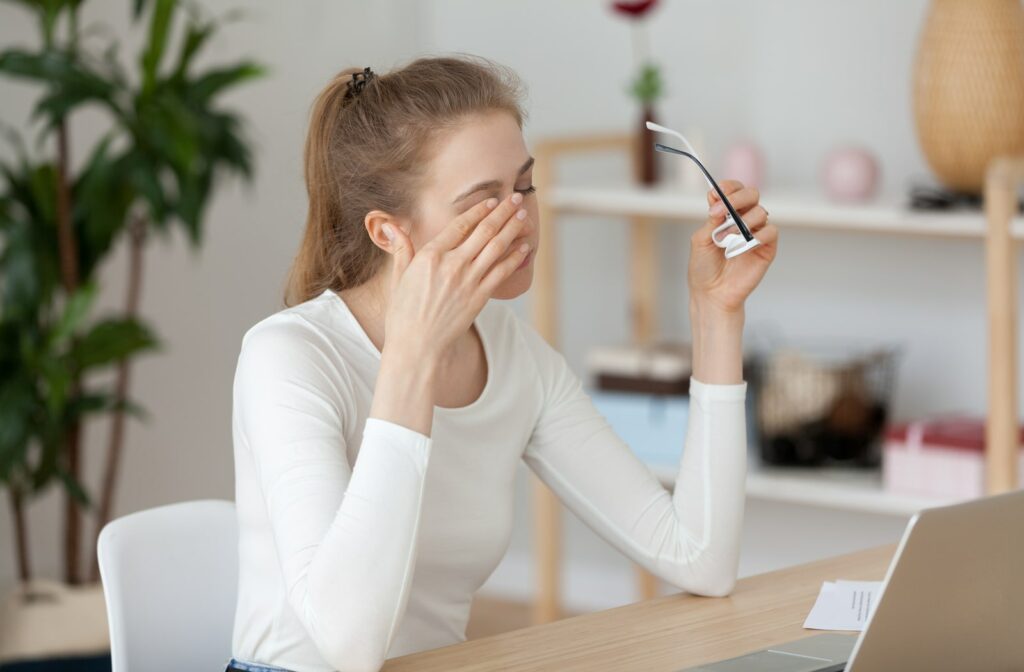Dry eyes are a common problem affecting almost 5 million Americans 50 and older. Many irritating and uncomfortable symptoms accompany dry eyes; floaters are not one of them.
Regular optometrist visits and eye exams are sometimes the only way to identify the cause of dry eye and floaters. Here, we explain dry eyes and floaters, their causes and symptoms, and possible treatment options.
All About Dry Eyes
Dry eye is one of the most common ocular conditions where eyes are dry and red from:
- Lack of tear production
- Lack of quality tears
- Tears evaporate too quickly
Dry eyes are mild to severe and can lead to corneal damage and vision problems without treatment.
Causes of Dry Eyes
Other causes of dry eyes or factors that can cause dry eyes to flare-up include:
- Age
- Blepharitis—inflammation of the eyelids.
- Medications for high blood pressure, antihistamines, and antidepressants.
- Long-term contact lens wear.
- Autoimmune diseases such as rheumatoid arthritis and Sjögren’s syndrome.
- Environmental factors like wind, smoke, and dry climates
- Hormones, especially in women.
- Infrequent blinking with long hours spent in front of a computer screen.
Symptoms of Dry Eyes
Symptoms can become very uncomfortable and include the following:
- Irritated and inflamed eyelids
- Itching and burning
- Watery eyes
- Sensitivity to light
- In severe cases, you can experience blurry vision, halos around bright lights, double vision, and pain.
Treatment of Dry Eyes
Your optometrist can diagnose and treat dry eyes. Diagnosis can include a comprehensive eye exam, medical history discussion, a cornea, and inner eye examination, and tear quality measurements.
In most cases, symptoms of dry eyes can be well-managed. These involve progressive and innovative treatment options such as:
- Lipiview: Assesses tear quality with imaging technology.
- Lipiflow: Gently massages and sends warmth to the glands in the eyes.
- BlephEx: Cleans the eyelids by removing bacteria and debris that contribute to dry eyes.
Dry eye is usually treated with prescription artificial tears or drops to keep your eyes lubricated. Addressing inflammation, and other underlying conditions, taking supplements, protecting the eyes with sunglasses, and reducing screen time, are other methods to help with dry eye.
All About Floaters
Floaters are shadowy shapes that float across your vision. Symptoms of floaters can be lines, threads, dots, blobs, or cobwebs that appear, disappear, and dart away when you try to focus on them.
Floaters are an accumulation of protein fibres in the back of the eye in a gel-like fluid called vitreous. The shadows cast by these clumps are floaters and can be present in one or both eyes.
With age-related changes, the vitreous liquefies, shrinks, or changes shape and causes the material to float. They don’t usually cause any harm but can make it hard to see clearly.
Other Causes of Floaters
Floaters can have many different causes, and in most cases, they resolve on their own over time. The most common cause of floaters is the aging of the vitreous gel. Other causes include:
- Inflammation or eye injuries
- Bleeding in the eye
- Eye infection
- Retinal tear
- Retinal detachment
- Vitreous detachment
Floaters are usually not dangerous, and people mostly learn to live with them. However, if they affect your daily vision and you experience other accompanying symptoms, contact your optometrist to rule out serious vision problems.
The following are signs of a more serious condition:
- New floaters
- Increase in the number of existing floaters
- Flashes of light in one or both eyes
- Blurred vision in the center of the eye
- Peripheral vision loss
Treatment of Floaters
Diagnosis of floaters includes an eye exam to see the back of the eye and the vitreous liquid. Vitrectomy is a surgical procedure that involves removing the vitreous and replacing it with a solution to maintain eye shape.
Dry Eye Relief
Yes, dry eyes and floaters share a common contributor—age, and both lead to vision changes. You may experience dry eye symptoms together with floaters, but dry eyes do not cause floaters.
Floaters are usually harmless. But, sudden changes such as floater shape, size, intensity, light flashes, pain, blurred vision, or vision loss require immediate attention by your eye doctor. Precision Eye Care is always ready and happy to help find the right solution for your eyes.
Book an appointment with us today if you suffer from any symptoms of dry eye or floaters mentioned above.




